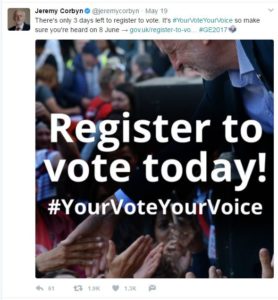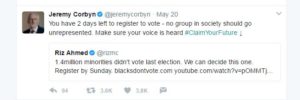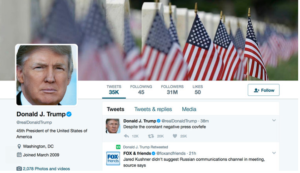The UK’s most social election yet?
General elections can be an odd, if not disrupting time for any society and without doubt impacts individuals differently. Some people have supported a party for their whole lifetime, by following in their family or friends footsteps or choose their own, different viewpoint. Others pay attention when the campaigning starts, not knowing at first who to believe and how it can affect them and their surroundings. But to the run up of most elections, people become engrossed in the news, live TV debates and manifestos, eventually understanding and supporting the party they believe represents them the most. A democratic election promotes unity and togetherness, the ideology of representing a country and the views of its people – but pre-election campaigns often have the reverse effect – dividing nations and their opinions.
Similar to B2B marketers, political parties have to use multiple channels to promote their manifestos and with the platforms of communication growing, parties have to adapt to make sure they are reaching their maximum audience.
Since the boom of social media, it has played an intense part in different areas of society, including covering all of the main stories during the general election. Politicians are able to express their views via popular channels (such as twitter, youtube, and facebook) as well as interact with opposing parties and general public for everyone to see. Social media not only encourages millennials to involve themselves in public affairs, it provides a better understanding of the political bodies in a more personal light. It also gives politicians the opportunity to spread their opinions across the world in seconds.
As expected, social media has become an integral part of campaigning for the surprise general election of 2017, called by Prime Minister Theresa May back in April. The main parties are using various platforms to express their views and back up their proposed manifestos.
By moving away from traditional campaigning methods such as print and adverts on TV and radio, politicians have drawn on social media and even famous figures to influence the public and increase voting volumes from millennials. Typically, generation X and Y would have voted previously, they already have an idea of who they support and the effect it will have on them. So political leaders like Jeremy Corbyn, Theresa May and Tim Farron have adapted their campaigning to reach out to the younger audience who have either not voted before or who are unsure on who can benefit them. By using social media, home to the millennials, political leaders have encouraged people to register to vote, discuss politics with their peers and become passionate about the direction of their country.
Labour in particular, have used social media to encourage people to register to vote leading up to the deadline. Jeremy Corbyn pushed this on his personal Twitter and analysis showed that 26% of his posts urged users to register. [The Press Association. https://www.pressassociation.com/]


Politicians have also taken it one step further and drawn on support from famous figures. Simon Cowell and Gary Barlow were both reported to be supporting the Conservative party whereas Joanna Lumley became an MP for the Green party. The “most intelligent man in the world” Stephen Hawking has openly spoke about how he will be voting for Labour in this year’s election. The Labour party have gained the attention of younger people by being endorsed by famous Grime artist Stormzy who pledged his support to the party by tweeting “My man, Jeremey. I dig what he says. He gets what the ethnic minorities are going through, and the homeless and the working class”. This spread across the internet in seconds, encouraging fans to create videos and memes of the political leader supporting Stormzy and his music.
Another example of political parties using different methods of social interaction is the Green Party’s use of YouTube.
In 2016 the Green Party were praised for putting together a video campaign which represented the political world today. The video featured children arguing against each other, bullying and struggling to make friends and was branded by The Huffington Post as “a bit over the top, but one of the best political broadcasts you’ll see this year”. [https://www.huffingtonpost.co.uk/entry/the-green-partys-political-broadcast-video-pits-children-against-each-other-as-david-cameron-and-jeremy-corbyn_uk_5704f9dae4b01e4956fcc520]
Using the hashtag #GrownUpPolitics the video trended on Twitter and Facebook and gained over 600 thousand views. By using a hashtag, the green party got people talking and most importantly interacting with the storyline of the campaign.
No matter the messages used by each party, [whether this be the ‘unite against the Tories’ campaign both Labour and the Liberal Democrats have pushed] social media has proven to have a positive impact upon most campaigns, encouraging people to ask questions, argue key points and share their opinions.
However, when social media is not used with care it can have an adverse effect, for example recently people speculated about a tweet written by Donald Trump, president of the United States of America, where he used the word ‘covfefe’, Trump never confirmed what the word meant or if it was a typo but the tweet has since been deleted. Small errors like this can damage reputations in minutes.

B2B marketers are not dissimilar from different political parties in the way we use many different methods of interaction. Social media is proven as an invaluable tool for B2B marketers to engage regularly with our audiences. It allows businesses to acquire and retain customers by having more human conversations than you have through other more traditional channels. The constant flow of content keeps consumers engaged with you and your brand, developing loyal followers. Platforms that are popular with B2B marketers include Facebook with 1.35 billion monthly users and Twitter with 317 million monthly users. These statistics offer real evidence as to why marketing is moving into an online, digital age, and how this can be extremely beneficial to both consumers and businesses alike. Hashtags are used to help people join discussions.
There is no doubt that social media plays a vital role in not only B2B marketing, but society as a whole. It has helped to push marketing in the right direction. Social media marketing offers much higher engagement levels and has an easier format for audience interaction. Content is more visible on social media and allows for interaction with brands and their posts, although strategic planning is what will drive the ROI. All the data you need is being spoon-feed from your potential B2B customers through social media platforms, but it is up to the marketer to initiate the invitation.
It will be interesting to see how the surprise election of 2017 unfolds, and what it means for B2B marketing. But from this election we can learn one thing; The different methods used by political parties and leaders can teach us as marketers that the more channels we reach out to our audience on and the more people’s attention we can grab the more likely we are to make an impact.
Polling stations are open all around the UK today, get down to your local one to make your vote count!
Tags: GE2017, General Election, social media, United Kingdom
